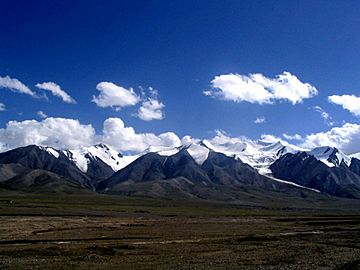Kunlun Mountains facts for kids
Quick facts for kids Kunlun Mountains |
|
|---|---|

Western Kunlun Shan
|
|
| Highest point | |
| Peak | Kunlun Goddess |
| Elevation | 7,167 m (23,514 ft) |
| Geography | |
| Country | China |
| State/Province | Tibet, Qinghai, Xinjiang |
| Borders on | Gobi Desert |
The Kunlun Mountains are part of one of the longest mountain chains in Asia, extending for more than 3,000 kilometres (1,900 mi). The chain forms the northern edge of the Tibetan Plateau south of the Tarim Basin.
The mountain range formed at the northern edges of the Cimmerian Plate during its collision, in the Late Triassic, with Siberia, which resulted in the closing of the Paleo-Tethys Ocean.
The range has very few roads and in its 3,000 km length is crossed by only two.
Over 70 volcanic cones form the Kunlun Volcanic Group. They are not volcanic mountains, but cones. As such, they are not counted among the world volcanic mountain peaks. The tallest mountain is called Kunlun Goddess and is 7,167 metres tall.
The group, however has the height of 5,808 metres (19,055 ft) above sea level. If they were considered volcanic mountains, they would constitute the highest volcano in Asia and China and second highest in the Eastern Hemisphere (after Mount Kilimanjaro) and one of Volcanic Seven Summits by elevation. The last known eruption in the volcanic group was on May 27, 1951.
Kunlun is originally the name of a mythical mountain believed to be a Taoist paradise. The first to visit this paradise was, according to the legends, King Mu (976-922 BCE) of the Zhou Dynasty. He supposedly discovered there the Jade Palace of the Yellow Emperor, the mythical originator of Chinese culture, and met Hsi Wang Mu (Xi Wang Mu), the 'Spirit Mother of the West' usually called the 'Queen Mother of the West', who was the object of an ancient religious cult which reached its peak in the Han Dynasty.
Images for kids
See also
 In Spanish: Kunlun para niños
In Spanish: Kunlun para niños




